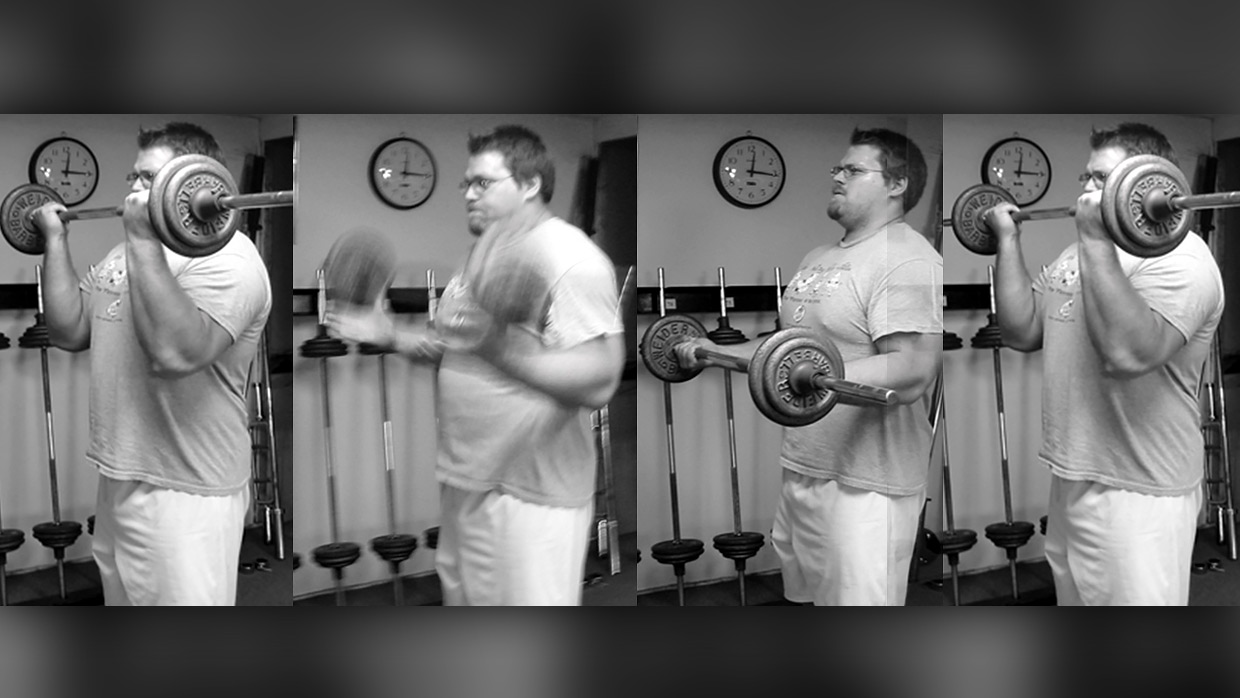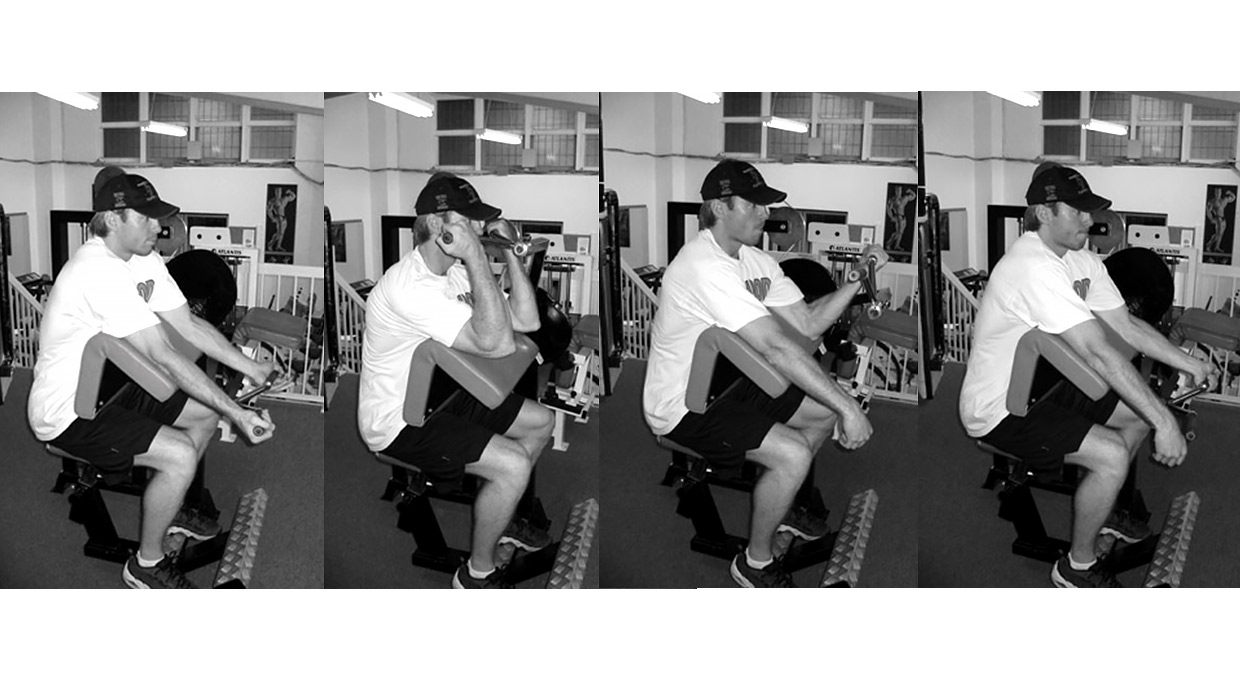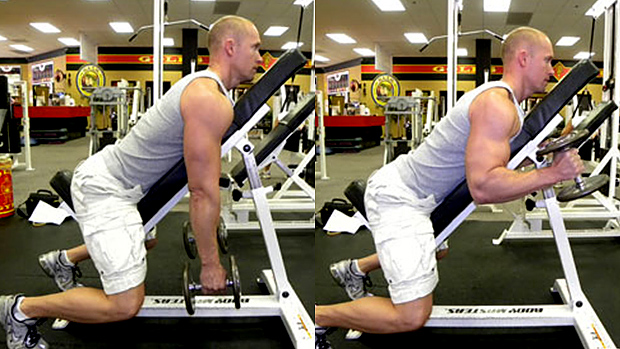01dragonslayer
Registered
- Joined
- Jun 18, 2022
- Messages
- 5,902
- Reaction score
- 3
- Points
- 38
Hey, are you in the mood for a quickie? No, zip up your pants, that's not what I'm talking about at all. What follows are three quick methods to break plateaus and maximize your gains in the shortest time possible.
That's why I designed this biceps program. Much to my surprise, it turned out to be one of the most effective I've ever used! So much so that I began to use it with bodybuilding clients too!
The routine is fairly simple. It starts with a triple set in which the first exercise is a potentiation movement (an exercise used to activate the nervous system so that you can ''turn on'' more fast-twitch fibers) followed by the main strength-building movement. The triple set is then concluded with a metabolic exercise performed at high speed, to improve power-endurance and coordination.
The set goes as follow:
10 seconds rest

This is a plyometric exercise for the biceps. You drop the bar from the starting position and let it free-fall down. You catch it with the elbows bent at a 90-degree angle. Now, the key point here is to abruptly halt the bar. In other words, stop it immediately after catching it. You do so by contracting the biceps and forearms as hard as humanly possible, as soon as your hands contact the bar. Once you've caught the bar stiffly, you lift it back up to the starting position.
10 seconds rest

3 minutes rest
Perform this triple set four times.

Here, the goal is to perform as many reps as possible in a given time frame, so the reps must be explosive! Make sure to perform the movement solely by using the biceps. Don't cheat by using your front deltoids as many people tend to do when trying to get a little extra speed.
Hold for 20-30 seconds per arm
120 seconds rest

In this exercise, you hold the barbell in the 90-degree position for 20-30 seconds. If you can hold it longer than that, increase the weight. It's very important to not just hold the weight, but to squeeze the biceps as hard as you can during the whole set.
3-4 reps per arm (6-8 total reps)
120 seconds rest

This is an eccentric overload movement: lift explosively with two arms, and lower the weight in 5 seconds with one arm. Change the lowering arm every rep.
B1 and B2 are performed alternatively (one set B1, one set B2, one set B1, one set B2, etc.), but not as a superset: rest for two minutes between exercises.
This program will allow you to improve tremendously the strength and size of your arm flexors. You'll improve strength in all types of contractions:
Reactive/ballistic
Concentric
Explosive
Isometric
Eccentric
This will give you a better transfer to sports performance.
This workout is based on heavy lifting, and is best suited for a period of high caloric intake.
120 seconds rest

This movement really allows you to pile on the weight! And since the triceps are mostly involved in the last portion of the pressing range of motion, even partial movements like this one will have a strong stimulatory effect. Start each rep from a dead start (bar set on pins).
120 seconds rest

90 seconds rest

90 seconds rest

That's it! Nothing too fancy, but perform this workout twice a week (Monday and Thursday) and within four weeks you'll reach new heights in both arm size and strength.
Obviously it's time for a change, but what should you do? Mirror training, that's what!
Don't worry, mirror training isn't about flexing in front of the mirror, or only training the muscles you can see in the mirror. Rather, it's about shocking your system by doing a program that's the exact opposite of the one you've been on. After all, if a program isn't working, the best thing to do is something different. Mirror training is as different as it gets.
Perhaps you're thinking, "But I do change my program, often!" Well, maybe so. However, if you're like 90% of the people in the gym, you probably make changes to your program in little bitty baby steps. You may change a few exercises, add or remove a set here and there, maybe bump the reps by two per set, whatever. If so, face it: you're doing pretty much the same program you were dong before you "changed" it.
Most people like to stay in their comfort zone, so they'll always revolve around a few concepts that they like and are familiar with. Even though the program seems to change, the nature of the program and the type of physiological stress it provides doesn't change enough to matter.
So, if you've been stagnating for a while, change your program completely. Here's a table that will help you design your ''mirror'' program.
Perform the mirror training for 4-6 weeks then get back to your former style of training. This is sure to give you a double boost in your gains: the first boost when you switch to mirror training, and the second boost when you get back to your old style.
1 The Power Biceps Blast
This is a biceps triple set that I've used with several football players. You may be asking yourself, "what does a football player need with big biceps?" While the biceps aren't exactly the most important muscle group for football performance, it does serve three main purposes:- The biceps are involved in many pulling movements that are often used by defensive linemen to separate themselves from their adversaries, and the biceps are also useful when tackling.
- They help protect the elbow joint from the high levels of force produced by the triceps during the pushing actions involved in football.
- Intimidation, baby! Visually impressive arms will always give a psychological advantage to a player. Plus, if you feel good about the way you look, it will make you more confident, and that itself will help you become a better player.
That's why I designed this biceps program. Much to my surprise, it turned out to be one of the most effective I've ever used! So much so that I began to use it with bodybuilding clients too!
The routine is fairly simple. It starts with a triple set in which the first exercise is a potentiation movement (an exercise used to activate the nervous system so that you can ''turn on'' more fast-twitch fibers) followed by the main strength-building movement. The triple set is then concluded with a metabolic exercise performed at high speed, to improve power-endurance and coordination.
The set goes as follow:
A1. BARBELL CURL DROP, CATCH AND LIFT
5-6 reps10 seconds rest

This is a plyometric exercise for the biceps. You drop the bar from the starting position and let it free-fall down. You catch it with the elbows bent at a 90-degree angle. Now, the key point here is to abruptly halt the bar. In other words, stop it immediately after catching it. You do so by contracting the biceps and forearms as hard as humanly possible, as soon as your hands contact the bar. Once you've caught the bar stiffly, you lift it back up to the starting position.
A2. INCLINE DUMBBELL CURL
6-8 reps10 seconds rest

A3. HIGH-SPEED CURL WITH ELASTIC TUBING
Max reps in 30 seconds3 minutes rest
Perform this triple set four times.

Here, the goal is to perform as many reps as possible in a given time frame, so the reps must be explosive! Make sure to perform the movement solely by using the biceps. Don't cheat by using your front deltoids as many people tend to do when trying to get a little extra speed.
B1. SINGLE ARM ISOMETRIC BARBELL CURL
4 setsHold for 20-30 seconds per arm
120 seconds rest

In this exercise, you hold the barbell in the 90-degree position for 20-30 seconds. If you can hold it longer than that, increase the weight. It's very important to not just hold the weight, but to squeeze the biceps as hard as you can during the whole set.
B2. MACHINE CURL 2/1 TECHNIQUE
4 sets3-4 reps per arm (6-8 total reps)
120 seconds rest

This is an eccentric overload movement: lift explosively with two arms, and lower the weight in 5 seconds with one arm. Change the lowering arm every rep.
B1 and B2 are performed alternatively (one set B1, one set B2, one set B1, one set B2, etc.), but not as a superset: rest for two minutes between exercises.
This program will allow you to improve tremendously the strength and size of your arm flexors. You'll improve strength in all types of contractions:
Reactive/ballistic
Concentric
Explosive
Isometric
Eccentric
This will give you a better transfer to sports performance.
2 Thib's Arms of Steel Workout
As long as we're talking arms, here's the program that's been my ''old standby'' every time new arm growth and strength has been desired. It's never let me down: whenever it was called for duty it always delivered the goods. I'm therefore pretty confident about giving it the ironclad Thib guarantee of new growth! But be warned: it's a highly stressful program, especially if you have small joints, so it shouldn't be used for more than 4 weeks, and never more frequently than twice a year.This workout is based on heavy lifting, and is best suited for a period of high caloric intake.
A1. PARTIAL CLOSE-GRIP BENCH PRESS
1x6, 1x4, 1x2, 1x6, 1x4, 1x2, 1x6, 1x4, 1x2 (9 total sets)120 seconds rest

This movement really allows you to pile on the weight! And since the triceps are mostly involved in the last portion of the pressing range of motion, even partial movements like this one will have a strong stimulatory effect. Start each rep from a dead start (bar set on pins).
A2. PREACHER CURL
1x6, 1x4, 1x2, 1x6, 1x4, 1x2, 1x6, 1x4, 1x2 (9 total sets)120 seconds rest

B1. DECLINE DUMBBELL TRICEPS EXTENSION
1x8, 1x6, 1x4, 1x1590 seconds rest

B2. REVERSE INCLINE HAMMER CURL
1x8, 1x6, 1x4, 1x1590 seconds rest

That's it! Nothing too fancy, but perform this workout twice a week (Monday and Thursday) and within four weeks you'll reach new heights in both arm size and strength.
3 Mirror Training
You've been pounding away at the weights for months and months with little, if any results to show for your efforts. Little by little, your motivation is dropping, and getting a good pump seems about as likely as getting a hard-on while being massaged by Brunhilda, the 275-pound former East German shot putter turned massage therapist.Obviously it's time for a change, but what should you do? Mirror training, that's what!
Don't worry, mirror training isn't about flexing in front of the mirror, or only training the muscles you can see in the mirror. Rather, it's about shocking your system by doing a program that's the exact opposite of the one you've been on. After all, if a program isn't working, the best thing to do is something different. Mirror training is as different as it gets.
Perhaps you're thinking, "But I do change my program, often!" Well, maybe so. However, if you're like 90% of the people in the gym, you probably make changes to your program in little bitty baby steps. You may change a few exercises, add or remove a set here and there, maybe bump the reps by two per set, whatever. If so, face it: you're doing pretty much the same program you were dong before you "changed" it.
Most people like to stay in their comfort zone, so they'll always revolve around a few concepts that they like and are familiar with. Even though the program seems to change, the nature of the program and the type of physiological stress it provides doesn't change enough to matter.
So, if you've been stagnating for a while, change your program completely. Here's a table that will help you design your ''mirror'' program.
| Training variable | Current program | Mirror program |
|---|---|---|
| Intensity level | Mainly low reps (1-4) | Mainly higher reps (13+) |
| Mainly moderate-low reps (5-8) | Mainly moderate-high reps (9-12) | |
| Mainly moderate-high reps (9-12) | Mainly moderate-low reps (5-8) | |
| Mainly higher reps (13+) | Mainly low reps (1-4) | |
| Volume | High volume (16-20 sets/muscle) | Low (less than 6 sets/muscle) |
| Moderate-high (10-15) | Moderate-low (6-9) | |
| Moderate-low (6-9) | Moderate-high (10-15) | |
| Low (less than 6 sets/muscle) | High volume (16-20 sets/muscle) | |
| Speed of movement | Lifting as fast as possible | Slow eccentric and concentric |
| Controlled eccentric; fast concentric | Slow eccentric; controlled concentric | |
| Slow eccentric; controlled concentric | Controlled eccentric; fast concentric | |
| Slow eccentric and concentric | Lifting as fast as possible | |
| Density | Long rest intervals (3-5 min) | Short rest intervals (less than 1 min) |
| Moderate-long RI (2-3 min) | Moderate-short RI (1-2 min) | |
| Moderate-short RI (1-2 min) | Moderate-long RI (2-3 min) | |
| Short rest intervals (less than 1 min) | Long rest intervals (3-5 min) | |
| Training split | Whole body | Push/Pull/legs split |
| Antagonist split | Upper body/Lower body split | |
| Upper body/Lower body split | Antagonist split | |
| Push/Pull/legs split | Whole body | |
| Exercise choice | Only compound movements | 1 to 1 compound to isolation |
| 2 to 1 isolation to compound | 2 to 1 compound to isolation | |
| 2 to 1 compound to isolation | 2 to 1 isolation to compound | |
| 1 to 1 compound to isolation | Only compound movements | |
| To failure? | Never go to failure | Failure on every set |
| Failure on the last set of an exercise | Failure only on the last set of a muscle | |
| Failure on every set | Never go to failure | |
| Number of exercises per muscle group | One or two exercise per muscle | Five exercises per muscle |
| Three exercises per muscle | Four exercises per muscle | |
| Four exercises per muscle | Three exercises per muscle | |
| Five exercises per muscle | One or two exercise per muscle |
